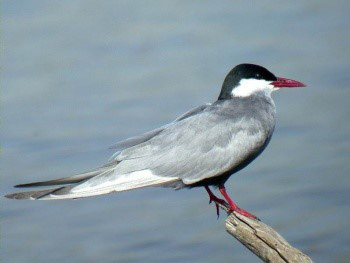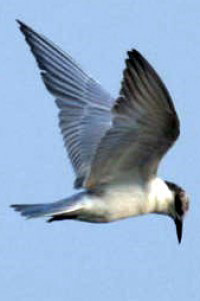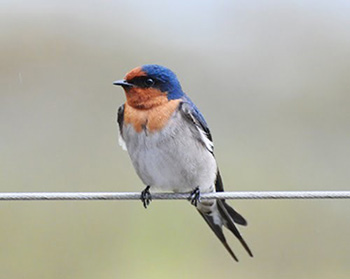The warm summer days have wafted towards Sanctuary Lakes and for the past few weeks we have been welcoming back our migratory neighbours. Modern technology has given us new insights into the where and whys of bird migration. It has even discovered that certain birds who were thought to be sedentary are in fact relatively nomadic. Swans for example have been found to regularly move around a 200 km radius, but there is no set migratory pattern, rather an opportunistic responses to either rainfall, drought, food supply or territorial security.
Migration is different; it is a set piece. The regular movement along flyways between continents, often south and north is marked by annual seasonality. Approximately 18% of the world's bird species are long-distance migrants. With the assistance of GPS banding, extraordinary migration flights are now being recorded. Last year an Arctic Tern, ringed (banded) as a chick on the Farne Islands off the Northumberland British East Coast, reached Melbourne, in just three months, a remarkable sea journey of over 22,000 km.
The primary motivation for migration appears to be food. Also, the longer days of the southern summer provide extended time for breeding birds to feed their young. This helps migratory birds to produce larger clutches. As the days shorten in autumn, the birds return north to warmer regions where the available food supply varies little with the season.
The physiological cue for migration are the changes in the day’s length. These changes are also related to hormonal changes in the birds. In the period before migration, many birds display higher activity.
Migratory navigation is based on a variety of senses, including using the sun as a compass, the ability to detect magnetic fields, using visual landmarks and recently discovered, cues along the flyways from odours particularly around their breeding grounds.
 Whiskered Tern (Chlidonias Hybrida) Two of Sanctuary Lake’s most populous and popular migratory birds are the Whiskered Tern (Chlidonias Hybrida) and the Welcome Swallow (Hirundo Neoxena).
Whiskered Tern (Chlidonias Hybrida) Two of Sanctuary Lake’s most populous and popular migratory birds are the Whiskered Tern (Chlidonias Hybrida) and the Welcome Swallow (Hirundo Neoxena).
The Whiskered Tern is sometimes called the Marsh Tern, a name which fits its preference for living in shallow terrestrial freshwater wetlands, brackish and saline lakes. That preference makes Sanctuary Lakes the perfect spot for the Whiskered Terns’ migratory summer vacation, congregating into substantial flocks of up to a hundred birds along our fairways, lake and ponds. The Whiskered Tern winters in the islands around Indonesia, Java and South East Asia. They migrate along the Australian Eastern Seaboard leaving or entering via the Top End.
 Whiskered Tern's distinctive flight position Their distinctive flight patterns, similar in my opinion to a jet fighter in combat, make them easy to recognise. Whirling dark grey wings angled upwards and beak pointing directly to the ground, swoop flying at a height of between 5 and 10 metres, rapidly patrolling back and forth turning dramatically and then suddenly, dipping down to snatch small insects and other invertebrates, or hawking for insects over the golf course; sometimes even plunge-diving into the lake or ponds to catch small fish.
Whiskered Tern's distinctive flight position Their distinctive flight patterns, similar in my opinion to a jet fighter in combat, make them easy to recognise. Whirling dark grey wings angled upwards and beak pointing directly to the ground, swoop flying at a height of between 5 and 10 metres, rapidly patrolling back and forth turning dramatically and then suddenly, dipping down to snatch small insects and other invertebrates, or hawking for insects over the golf course; sometimes even plunge-diving into the lake or ponds to catch small fish.
The Whiskered Tern’s plumage is as equally distinctive with a black head crown and white cheeks and sides of neck. The upperparts, upper wings and tail are medium grey, the underparts dark grey to slate grey and the under tail and the underwings mainly white, with a slightly forked tail. The eye is brown and the bill and legs are a bright red. The call is a characteristic Krekk.
The breeding season of the Whiskered Tern is erratic depending on weather and can be anytime between November and February. They tend not to nest in Sanctuary Lakes, but breed in loose colonies in large, often temporary, inland swamps and marshes. The nest is a rough raft of vegetation, either floating or moored. The sexes share nest-building, incubation and care of the young. A single brood of three to five chicks is usually raised in a season.
The Whiskered Tern’s genus name Childonias is from Ancient Greek Khelidonios, meaning “swallow-like", which segued us perfectly to our other migratory bird the Welcome Swallow.
Australia’s native swallow, the Welcome Swallow can be seen fluttering, swooping and gliding in search of flying insects in almost every corner of Sanctuary Lakes. Sometimes they even fly over the wetlands and out into the bay. The name “Welcome” Swallow comes from the early colonial sailors who knew that the sight of the swallow meant that land was not far away.
 The Welcome Swallow (Hirundo Neoxena)Welcome Swallows are happy living with people, building their tiny mud and grass nests in many different situations, though most noticeably beneath gutters, eaves and on the walls of buildings, always avoiding direct sunlight. Last year there were two nests around the Club House, one on the Waterstone/Gym building and another on the Maintenance Shed. Some of my neighbours have discovered nests hidden in grannies of their house gutters and eaves. Their tiny nests are made by both sexes and are lined with feathers and fur. The female alone incubates the eggs but the young are fed by both parents. Often two broods of three to five chicks are raised in a season.
The Welcome Swallow (Hirundo Neoxena)Welcome Swallows are happy living with people, building their tiny mud and grass nests in many different situations, though most noticeably beneath gutters, eaves and on the walls of buildings, always avoiding direct sunlight. Last year there were two nests around the Club House, one on the Waterstone/Gym building and another on the Maintenance Shed. Some of my neighbours have discovered nests hidden in grannies of their house gutters and eaves. Their tiny nests are made by both sexes and are lined with feathers and fur. The female alone incubates the eggs but the young are fed by both parents. Often two broods of three to five chicks are raised in a season.
The Welcome Swallow is sometimes confused with the Barn Swallow and the Tree Martin, but can be simply distinguished by its distinctive metallic blue-black cap, light grey breast and belly, and red rust on the forehead, throat and upper breast. It has a long forked tail, with a row of white spots on the individual feathers. The outer tail feathers (streamers) are slightly shorter in the female.
Welcome Swallows feed on a wide variety of insects. They catch prey in flight, using their acrobatic flying skills. The prey is guided into the bird's wide, open mouth with the help of short rictal bristles bordering the bill. These bristles also help protect the bird's eye. Sometimes in Sanctuary Lakes, particularly after rainfall, insects are in large supply, Welcome Swallows like to party and feed gregariously in large flocks showing off their agile flying abilities. They eat approx. 400 times a day! (That’s every 2 minutes) and need to eat their own body weight daily to maintain their health and energy.
The Welcome Swallow is a migratory bird. As winter approaches the majority will move towards Far North Queensland and Torres Strait placing them closer to the equator and warm weather. The following spring, they will return to the Sanctuary Lakes to breed. Recently it has been discovered that some swallows who do not make the journey north are in the main, non breeding adults and the young of the second brood.
Without doubt new technology will give us greater understanding of bird migration but threats to migratory birds have grown recently with habitat destruction especially at stopovers and wintering sites, as well as increased building structures such as power lines along the flyways. Fortunately our neighbours the Whiskered Tern and the Welcome Swallow are holding their own.